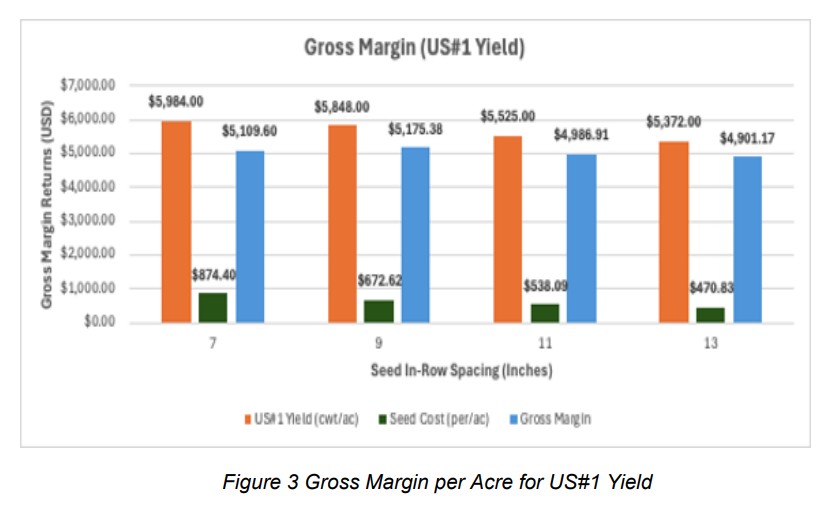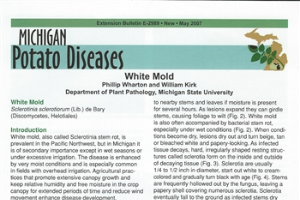
Economics of Potato Seed Spacing and Planting Depth in Potato Production
DOWNLOADApril 3, 2025 - Steve Whittington, Phabian Makokha, Chris Long, and Stephanie Kipp
Introduction
Michigan is among the top ten potato producing states in the United States with a large component of the Michigan Potato Industry dedicated to supplying potatoes for nationwide chip manufacturers. Michigan State University (MSU) has invested decades into advancing potato variety development to support and strengthen the industry.
However, even after varieties are developed to meet specific agronomic traits, the optimal growing practices to maximize yield and economic profitability for the new released varieties are generally unknown. Therefore, optimizing seed spacing and planting depth is essential in order to maximize yield and increase overall profitability in potato production. Narrower in-row seed spacing may increase yield, but the economic profitability given the additional costs is unknown. Varieties also vary in their response to seed spacing and seed depth as well. Therefore, it is important to identify the optimal combination of seed depth and spacing preferred by varieties to maximize economic profitability. In this first -year study, we evaluated the effects of seed spacing and planting depth of two newly released chip-processing varieties: Bliss and Mackinaw. The preliminary findings indicate that closer seed spacings increase economic profitability considering additional cost of seed.
Trial Procedure – Year 1
The study was conducted at MSU Montcalm Research Center in Lakeview, MI, between May and September 2024. Treatments included two newly released varieties Bliss and Mackinaw, and Lamoka, an old variety. Four in-row spacings were used: 7-, 9-, 11-, and 13-inches, with 9-inch as the standard industry practice. Planting depths were 3-, 5-, and 7-inches, with 5-inch as the industry standard. The trial was set up as a randomized complete block design with four replicates. Trial plots consisted of three-row plots with each row measuring 15 feet long and 2.8 feet wide. Certified potato seed was cut by hand to an average seed piece of 2.5 oz and treated with CruiserMaxx Vibrance® and suberized for one week at 50oF prior to planting.
The trial was planted on May 13 and 14, 2024. A two-row-assist-feed planter was used to open rows. The potato planters’ covering discs were set to avoid covering the furrows, allowing furrows to remain open. Seed pieces were hand planted using trowels with vertical marked distances to estimate the planting depths during seed placement. All other agronomic practices followed local grower practices as recommended by MSU Extension for commercial potato production. Vines were killed at 112 days after planting (DAP) and harvest was at 134 DAP.
In-season data were collected on stand emergence, stem number, vine vigor, and vine maturity. Post-harvest assessments included total and US#1 yield, tuber size distribution, specific gravity, and internal tuber traits. The US#1 yield comprised of A1, A2, and oversize tuber yield. Tuber sizes were categorized as B grade (< 17/8’’), A1 grade (17/8’’- 25/8), A2 grade (25/8 – 31/4), over-size (>31/4), and culls. Grower returns were estimated using chip contracts based on US#1 yield and total yield for seed spacing and depth. Gross income was calculated based on average yield and price per hundredweight using current fresh price of $17/cwt. Gross margin was calculated to determine economic profitability with the increase in yield and additional seed cost.
Preliminary Results
The economic analysis is based on yield outcomes of the study using total yield and US#1 yield with a fresh price of $17 (cwt/ac). The only variable cost considered in the study is additional seed cost. Seed quantity and costs increased with closer in-row seed spacing. Seed spacing significantly affected grower returns, while planting depth and their interaction did not. Grower returns improved with closer seed spacing, with profits rising 2-11% at 7-inch spacing when compared to 9-, 11-, and 13-inch seed spacing.
Total and US#1 Yield
Total and US#1 yield gross income increased with closer seed spacing (Figure 1). The 7-inch seed spacing produced the highest total yield and US#1 yield compared to 9, 11, and 13-inch seed spacing.
Total Yield and Gross Revenue
Gross revenue is the total revenue before any variable production costs are considered. Gross margin is the remaining revenue after variable production costs are considered. The only variable production cost considered is additional seed cost. Revenue was calculated with a unit price of $17 cwt/ac. It is economically profitable to plant at 7-inch seed spacing given the additional cost of seed based on total yield output (Figure 2).
US#1 Yield Gross Revenue
It is no longer economically profitable to plant at the closest seed spacing of 7-inches using a US#1 grading. A 9-inch spacing now achieves a higher gross margin with additional seed costs, and is therefore more economically profitable. (Figure 3).

Variety and Seed Depth Total Yield Gross Revenue
Bliss variety achieved the highest gross revenue of $7,123 at a planting depth of 7-inches. Lamoka variety achieved the highest gross revenue of $6,035 at a planting depth of 7-inches. The Mackinaw variety achieved the highest gross revenue of $7,395 at a planting depth of 5-inches (Figure 4). Mackinaw demonsrates a preference to be planted at shallower depths.
Variety and Seed Depth US#1 Yield Gross Revenue
Bliss variety achieved the highest gross revenue of $6,052 at a planting depth of 7-inches. Lamoka variety achieved the highest gross revenue of $5,372 at a planting depth of 7-inches. The Mackinaw variety achieved the highest gross revenue of $6,545 at a planting depth of 5-inches (Figure 5).
Preliminary Conclusions
The first year of research found that smaller, more intensive in-row seed spacings in general are more economically advantageous for producers. When a $17 cwt/ac value is used, gross income can be calculated to quantify a dollar value of total yield and US#1 yield per acre. This study considered seed cost as the only variable cost of production to determine if additional seed costs justified closer seed spacing. In terms of total yield, it is economically advantageous to plant a closer seed spacing considering the additional variable cost of seed required. However, in terms of US#1 yield grading, it is no longer economically profitable to plant at the closest seed spacing of 7-inches, but 9-inches considering additional seed costs. Variety and seed depth shows that Bliss and Lamoka achieve the highest gross revenue at a greater planting depth of 7-inches, whereas Mackinaw achieves a higher gross income at a planting depth of 5-inches. This could be due to the Mackinaw variety demonstrating a preference for shallower seed depths.
The researchers recognize that other factors not measured in the year-one research may influence yield such as agronomic conditions, planting and harvest timing, and irrigation. There could also be outcomes other than yield output that are of importance to producers as well such as specific gravity, tuber uniformity and quality, disease resistance, tubers per plant, and skin thickness. Additionally, the researchers understand that variable costs other than seed costs have an effect on production costs with closer seed densities such as the increased level of nutrients, fertilizer, chemical products, and water usage requirements which were not considered in year one.
It is important to note that these results are based on one year of data and are not conclusive. Further analysis in subsequent years will provide a clearer understanding of these trends. While closer seed spacing may enhance yield, it also increases seed costs and other variable costs due to higher plant populations. These findings are from the first year of the study, a multi-year evaluation is needed to confirm the consistency of this trend for growers. Michigan State University will continue this research to develop this research in subsequent years in order to maximize producer’s economic value with planting recommendations.
MSU is an affirmative-action, equal-opportunity employer, committed to achieving excellence through a diverse workforce and inclusive culture that encourages all people to reach their full potential. Michigan State University Extension programs and materials are open to all without regard to race, color, national origin, gender, gender identity, religion, age, height, weight, disability, political beliefs, sexual orientation, marital status, family status or veteran status. Issued in furtherance of MSU Extension work, acts of May 8 and June 30, 1914, in cooperation with the U.S. Department of Agriculture. Quentin Tyler, Director, MSU Extension, East Lansing, MI 48824. This information is for educational purposes only. Reference to commercial products or trade names does not imply endorsement by MSU Extension or bias against those not mentioned.



 Print
Print Email
Email






